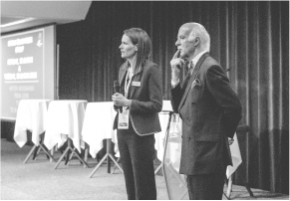- About
- Programs
- Innovation & Research
- Campus Life
- Career Services
- Admissions
- News & Events
- Alumni
What Is a Boardroom? A Closer Look at Business Decisions
Learn what a boardroom is, who uses it, and why it’s vital for business education and professional success in today’s corporate world.
Key Takeaways
- A boardroom is not just a physical space but more so the group of people and the decision-making process that shapes an organization’s strategic direction.
- Board meetings bring together directors, executives, and sometimes external experts.
- Modern boardrooms are equipped with tools like video conferencing systems, data presentation screens, and collaborative tech that support clear communication and informed decision-making.
- Professional etiquette matters, as punctuality, respectful communication, and confident yet courteous participation all reflect readiness to lead in the boardroom.
There's a certain setting that comes to mind when we think of big decisions being made: people gathered around a table, papers neatly stacked, coffee cups in hand, each voice carrying weight. It's the classic picture of a boardroom as the supposed nerve center where strategies are made and futures are decided.
However, the truth is, it's not really about the room. A boardroom could be a glass-walled office on the top floor, a plain meeting room with whiteboards, or even a virtual space on a video call. The setting itself doesn't define it. The real answer to what a boardroom is lies in the people and the conversations they have.
What Is a Boardroom?
Although the term “boardroom” in part is used to describe the formal room where a board of directors meets, in the business world, it more so refers to the gathering itself. Technically, it could be any space, physical or virtual, where executives come together to make decisions about an organization. That's why terms like board meeting and board of directors have become more widely used. They better reflect the function and the participants, not just the location.
While the physical setup often includes a large table and presentation screens, these are only practical details. What matters is the purpose: management, strategic decision-making, accountability, and governance.
As noted by Spencer Stuart, the global executive search and leadership consulting firm, the board exists to bring collective wisdom to complex decisions. It is where power and responsibility meet. Directors are tasked with balancing the interests of stakeholders, using their authority to make decisions that protect and advance the company's long-term goals. While board codes differ across jurisdictions, this fundamental purpose remains universal.
Therefore, in that sense, asking "What is a boardroom?" really means asking who sits at the table, how they think, and what they stand for. Because a boardroom is not about the room at all. It's about the vision created within it.
Your Leadership Journey Starts Here
Master the art of hospitality management
Who Uses the Boardroom?
Central to board meetings are the board of directors. They are the individuals elected to represent shareholders and oversee management.
The people using boardrooms are not always company employees. Many are external experts who are chosen for their strategic insight, industry knowledge, or governance experience. Their role is to guide the company, challenge decisions constructively, and ensure accountability.
Therefore, board meetings typically include:
- Directors
- Top executives like CEOs or CFOs
- Department heads or managers
- External advisors or consultants
Progressive boards recruit directors to reflect strategic priorities and stakeholder diversity. This includes ensuring a balance of executive and non-executive members, with many jurisdictions recommending at least 50% independent directors to ensure objectivity.
For example, in Switzerland, 88% of boards include independent directors, reflecting a strong emphasis on governance and impartiality. The recruitment process is rigorous, often involving professional advisors to maintain transparency and avoid biases. Such diligence helps guarantee that boards are diverse and avoid groupthink.
At César Ritz Colleges, we share that same commitment to diversity as a principle of good governance as well as a part of education. With over 40 nationalities represented on campus, our students learn the value of working in multicultural teams and develop the inclusive mindset that modern leadership demands.
We believe the best ideas emerge when people of different perspectives come together, which is why preparing future professionals to embrace diversity is embedded in everything we do.
What Happens in a Boardroom Meeting?
A board meeting is where the most strategic and sensitive decisions of an organization are made. It is not just a place for executives to sit and nod through updates. These meetings provide the space where directors can challenge, evaluate, and refine proposals that influence the company's direction.
Typical activities in a boardroom meeting include:
- Reviewing company performance reports
- Discussing financial statements and budget allocations
- Planning strategic initiatives for growth
- Making decisions on mergers, acquisitions, or partnerships
- Evaluating risks and compliance issues
- Approving policies and corporate governance frameworks
- Reviewing and updating organizational goals and KPIs
Key Features of a Boardroom
While today's boardroom can technically be any meeting space, certain physical and technological elements support its function as a strategic decision-making hub.
Typical features of a boardroom include:
- A long conference table with comfortable chairs to seat directors and executives
- High-speed video conferencing systems to connect with remote directors or international stakeholders
- Presentation screens or projectors for financial reports, data dashboards, and strategic proposals
- Integrated microphones and audio systems to ensure clear communication
- Whiteboards or smartboards for brainstorming and recording action items
- Secure Wi-Fi and power access at each seat for laptops or tablets.
Another feature that is slowly becoming crucial for these meetings is artificial intelligence. In recent years, board-level oversight of AI has expanded rapidly. Over 31% of S&P 500 companies now disclose some form of AI governance, whether through dedicated committees, directors with AI expertise, or ethics boards. In fact, having at least one director with a background in AI has nearly doubled since 2022, which indicates the importance technological fluency has at the highest levels of decision-making.
In some cases, AI is literally joining the meeting. In 2024, Abu Dhabi's IHC appointed Aiden Insight, a virtual human powered by generative AI, as a board observer. While Aiden doesn't vote, its participation is recorded in the minutes. It listens in real time, identifies key points of discussion, and offers suggestions or insights based on the company's data and broader market trends. The goal isn't to replace directors but to augment their capabilities.
Why the Boardroom Is Important in Business Education
Boardrooms may seem like something reserved for the later stages of a career, settings where only top executives gather to make big decisions. However, the truth is, the habits and thinking that define success in those rooms start taking shape much earlier.
Those aspiring to become leaders and join such boards shouldn't wait until they're seated at the table to begin understanding how it works. Research shows that without structured, practical communication training, graduates often struggle to transition into professional roles. This highlights the need for academic programs to make business communication a core part of leadership development, not just an add-on.
The best programs embed business communication education directly into their curriculum, helping students bridge the gap between classroom learning and boardroom practice. Through simulations, case presentations, and observation of real meetings, students build leadership qualities that can't be picked up from textbooks alone—things like strategic thinking, persuasive speaking, confident delivery, and professional presence under pressure.
At César Ritz Colleges, these experiences are central to our programs. We help provide leadership training to our students through classes centered on practice, internships, and jobs with global brands to boardroom-style project evaluations, and even access to the International Recruitment Forum (IRF).
Our students are constantly challenged to think like professionals. Courses emphasize leadership, strategic decision-making, and communication in multicultural settings, guaranteeing that when our graduates step into real boardrooms, they're ready for it.
Boardroom Etiquette for Future Professionals
Professionalism in a boardroom is as much about what you say as it is about how you carry yourself in silence, too. Your presence should signal that you are attentive, respectful, and ready to contribute meaningfully to the conversation. Following these guidelines can help you leave that impression:
- Be punctual: Arriving early shows respect for others' time and allows you to settle in before discussions begin.
- Dress professionally: Follow the organization's dress code. If you're unsure about what it is, it's always safer to lean toward formal business attire.
- Practice active listening: Pay close attention to what's being said instead of preparing your response while others are talking.
- Communicate clearly: Speak with confidence and keep your points concise. Avoid filler words and tangents.
- Respect others' contributions: Don't interrupt. Acknowledge strong ideas and maintain composed body language, even when you disagree.
- Be mindful of your nonverbal cues: Posture, eye contact, and facial expressions all send signals, so make sure yours show focus and openness.
- Use digital devices discreetly: If you must use a laptop or tablet, keep it related to the discussion and never let it distract from the meeting.
- Know when to speak: Sometimes, the most effective contribution is knowing when to speak or when to hold back and let the conversation unfold.
Gain a Seat at the Boardroom Table
Understanding how boardrooms operate and what they stand for is essential for students getting ready to enter the business or hospitality industries. It also helps them develop their strategic thinking and leadership skills.
That's why a degree in leadership, such as our Master of Science in Leadership, is valuable for anyone with ambitions to influence direction at the top, whether your background is in hospitality, finance, marketing, or sustainability. Boards are made up of professionals from across sectors, and what unites them isn't identical expertise but their ability to think long-term and act with integrity.
As our slogan says, 'Learn to lead. Lead to succeed.' At César Ritz Colleges, we guide you to become a professional ready for the boardroom, but, more importantly, a professional capable of shaping what happens there.
Frequently Asked Questions
What is the difference between a boardroom and a conference room?
A boardroom is typically reserved for high-level strategic meetings, whereas a conference room is more commonly used for general team or departmental meetings.
What is a digital boardroom?
A digital boardroom is a virtual or tech-enhanced meeting space that uses advanced tools, like video conferencing and data dashboards, to support decision-making remotely or in hybrid formats.
Can smaller companies benefit from a formal boardroom?
Definitely! Even small companies can gain value from structured board meetings, as they help guide strategic growth and invite expert perspectives into major decisions.
Do you dream of a career in the hospitality business? Start your application and take that first step.




















